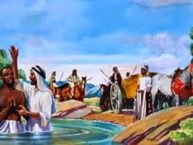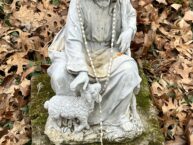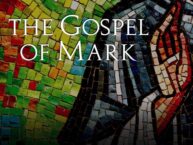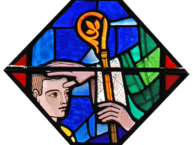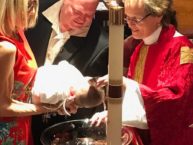 December 2, 2018: May God’s words alone be spoken, may God’s words alone be heard. Amen.
December 2, 2018: May God’s words alone be spoken, may God’s words alone be heard. Amen.
What a gospel, right? Jesus says “There will be signs in the sun, the moon, and the stars…People will faint from fear and foreboding of what is coming upon the world…Now when these things begin to take place, stand up and raise your heads, because it’s time to put on your sneakers, head to the malls, or get out your computer, to ensure you get the best of the Christmas shopping deals before they are snagged up!”
Okay, maybe not what Jesus was talking about in the gospel passage from Luke today, but if you have ever shopped on Black Friday or Cyber Monday, the chaos can raise your blood pressure a bit. Yet, for us here at Christ Church, we are ready for this reading today, because we have been paying attention – we have been in the midst of the third year of our return to the original seven week Advent, and we have noticed these apocalyptic passages that have been our readings since after All Saints – as they do every year to begin Advent. And so we know too, that just like our secular New Years, we always start Advent with a few fireworks of our own.
Now, our culture loves the idea of an apocalypse, right? Of some sort of end times. Heck, back in 2009, there was a movie titled 2012. In it, the end of the world happens in 2012 – all previously prophesied by ancient civilizations. I suggest we show it to younger people and tell them it’s a documentary, and then tell how we bravely managed to survive it all. We could even get t-shirts for them that say – “My parents survived the end of the world, and all I got was this lousy t-shirt!” Fun family times, right?
And we hear Jesus talking about something like that, right? But, here’s the thing – the word apocalypse, despite what Hollywood and some religious cults will tell you, does NOT mean end times, the destruction of all life, or any such thing. The word is from the Greek ἀποκάλυψις,which means to reveal – to make known some secret knowledge – usually to inform us about our existence, about God, or to help make sense of the reality of heaven or earth. Which is why this gospel passage from Luke, like the others that always are our start to Advent, is an apocalyptic reading – not because of the end times narrative within them, but because Jesus is using those stories to reveal something to us about heaven and earth – about who we are, and who he is. The so called end times isn’t the point, but rather Jesus is focusing on death & new life – hope & despair – fear & love. And even if there is destruction and chaos, isn’t something to happen once, but continually – then, now, and tomorrow. So, in a sense, maybe Hollywood is partially right after all – it is “Apocalypse Now.”
And it is this cyclical life that Jesus is telling us about, and what we already experience every day and every year, if we really think about it. So yes, this passage from Luke, like the ones in the other synoptic gospels of Matthew and Mark, is about chaos and the return of Christ. Unfortunately, there are some who have taken this all in quite a linear way, predicting certain dates for the end times and this mighty return. But for us to believe that, we have to abandon some things we claim to believe. First, one must believe in some sort of sadistic God, who would destroy innocent creatures of the earth. This was part of ancient theology, but we know that God is love – unconditional, undeniable, infinite love. We also know, as a people of Christ, that Jesus isn’t sitting in some place far away from us biding his time binge watching epic dramas on Netflix until some “second coming” – he is with us always – he has already come, he is present now, and he will return tomorrow and all our tomorrows. We proclaim this mystery of faith every Sunday – Christ was, and is, and is to come. It’s just that we sometimes lose sight of this central tenet of our faith.
So, if Jesus isn’t telling us about some distant destruction of the world, what is he getting at here, what is he trying to reveal? And, as always, why is it important to us? I think Jesus knew that we, like his disciples, would need some help with this, and so he offers a parable to explain his words. He says “Look at the fig tree and all the trees; as soon as they sprout leaves you can see for yourselves and know that summer is already near. So also, when you see these things taking place, you know that the kingdom of God is near.”
You know what else you understand from that parable? The tree will lose all its leaves again…the following winter. It is a cycle of life and death, dormancy and vibrancy – and we can choose how to react and live within it. Maybe Jesus today would use a line from one of those Netflix series and say instead “Winter is Coming!” “Winter is Coming!” Truth be told – in as much as Jesus was, and is, and is to come…so too is the winter – the chaotic times – it is always present in one form or another. But then he would offer a parable to say that “Spring is Coming!” – and will always come.
The truth is, throughout the history of the world there has been, is, and will be destruction, war, tumult…because since the beginning of human history, we are flawed and capable of losing our way, of walking in fear – and fear leads to greed, arrogance, hate, bigotry, oppression, and violence. We need only look at the rampant racism, heterosexism, misogyny, and inequity that abounds all over our nation and the world to know that, right? Jesus is clear though, that when these things happen – and they always happen – we need to be his people, to remember he is present – to abide in him, because it is then, most of all, that the he is most near to us, and it is then that as the body of Christ, we have work to do.
Now, I want to pause here for a moment to tell you a bit of what happened here at Christ Church yesterday – to offer it up as an apocalypse, if you will, much like Jesus did in the gospel.
Yesterday, we hosted once again the Dzieci Theatre Company of New York City in their production called “Fool’s Mass.” It begins in chaos, with the characters, costumed in medieval clothing of the poor and outcast, running about, one clanging a bell, while another telling him to be quiet. We were eventually led into the church, greeted by other characters – each of them carrying a bit of anxiety mixed with pure joy that a Mass was to begin. You see, their beloved priest had not arrived, hence all the confusion for them. Everything is set for the Mass, …and one goes to find the priest, returning to announce that he is dead. After a brief moment of despair, they decide they must continue with the Mass. And so, the service begins….
The various attempts at reading the gospel, or setting the table for the Eucharist, had us all laughing at the sheer joy of what was happening. Yet you could sense the wonder and powerful witness to Christ during the “sermon,” in which one of the cast members told the story of this group of “fool’s” and their beloved pastor. You see, no one wanted them. They had nothing. They were outcasts. Their pastor took them in, and gave them shelter and food, and taught them how to sing – beautifully too. The sermon was a reminder of how one person can make a difference in the name of Christ.
The service than continued, and as it is Advent the Eucharist was set in the context of a nativity play, and as with any pageant, the chaos was joyful and abundant. Then there was a point when one of the fools, who was playing “Mary” in the nativity scene, made clear it was time for her to give birth. In a very loud and chaotic birth moment – well, shouldn’t it be told that way? Silent night, does not really describe most delivery rooms, right? Anyway, at one point “Mary” makes a very loud groan, and one of the others delivers from her a large loaf of bread and holds it aloft. Jesus, the bread of life, is born! I stared in wonder at this meaningful telling of the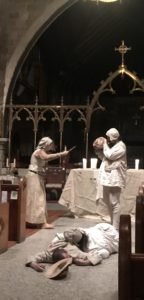 birth of Jesus. All those gathered were struck with awe…and so we are shocked into the depths of our souls when another cast member grabs a large knife and stabs it directly into the center of the bread. Jesus is crucified.
birth of Jesus. All those gathered were struck with awe…and so we are shocked into the depths of our souls when another cast member grabs a large knife and stabs it directly into the center of the bread. Jesus is crucified.
Not a word or movement was made – just the vision of what had just happened. It was a Eucharistic prayer unlike any other. A powerful gospel of the love made flesh sacrificed for us. The mass ended in a peaceful and joy filled benediction. These medieval “fools” had turned chaos, heartache, and death, into peace, joy, and love – and they did it by keeping Christ in their hearts – abiding with him who is always present. – and thereby they revealed Christ to us. This was the good news Jesus was revealing to his disciples – that chaos will come, but that is when he is most near…and as winter turns to spring, so too will chaos turn to peace, if we abide in him, and then be him in the world.
So, how do we – the “fools” today – amidst the pain, chaos, death, and destruction of our times – abide with Jesus? We do as he asked – raise our heads. Really, if we break down the Greek – he is asking us to bend backwards with our face to the sky – to put our whole body and soul into focusing on him, and in that way, we walk as he walked – in love. In that way, we become the people of hope we are called to be – the Advent people that we are, for a world in need.
Still, how do we do that when the chaos of our daily lives pull us in so many directions, when the constant cycle of news fills us with despair and righteous anger, when we and those around us are struggling physically, emotionally, spiritually? How do we manage this type of courage – and it is courage he calls us to, make no mistake about it – if we are to be the people he needs us to be. Perhaps we remember that courage, like a sacrament of the church, is the outward and visible sign, of an inward and spiritual grace – and that grace is the hope and love found in Jesus Christ, if we keep him in our hearts. And to do that, to keep him in our hearts – we need to be fools too…and that takes practice.
Advent is the beginning of our church year, and a perfect time to make New Year’s resolutions, and I am asking that we all resolve to adopt the spiritual practice offered by our Episcopal Church. Our Presiding Bishop, the Most Rev. Michael B. Curry, is calling each of us in the Episcopal Branch of the Jesus Movement to adopt a rule of life this Advent. A rule of life is a spiritual practice, most often associated with monastic life, but everyone who follows Jesus is truly called to live one. It is inherent in the very name given the earliest followers of Jesus, whose gospel movement was called “The Way.” And this Advent, our church is providing some tools to help get everyone reoriented to that call – to being the Advent people of hope we were meant to be amidst the chaos – to walking The Way of Love in the world. Each of you should have received a sheet of paper as you walked into worship today (and for podcast listeners, see the link at the end of this sermon).
On one side of the paper is an invitation from Presiding Bishop Curry to enter into this rule of life in Advent. He writes “…how can we together grow more deeply with Jesus Christ at the center of our lives, so we can bear witness to his way of love in and for the world? …The Way of Love: Practices for a Jesus-Centered Life– outlines a Rule for the Episcopal branch of the Jesus Movement…By entering into reflection, discernment and commitment around the practices of Turn – Learn – Pray – Worship – Bless – Go – Rest, I pray we will grow as communities following the loving, liberating, life-giving way of Jesus. His way has the power to change each of our lives and to change this world.”
Indeed it does.
And so let us walk The Way of Love – let us practice that Christ centered life – that we too may experience Jesus fully every day of our lives. This is, as rules of life should be, simple and mindfully focused on one thing each day. And here is how we get started…
On the other side of the paper is an Advent calendar. Each day on the calendar there is a single thing to do, to consider, to step into as part of your practice.
Today it will be Worship, Tomorrow Go, Tuesday Learn, and so on – each with one singular act to help you in your practice, and then the cycle repeats next week, with a new set of practices. In today’s practice, each of you are asked to “Pay attention during worship.” (I like that) But, more than that, the rule asks that you consider “What part of the gathering fills your heart?”
“What part of the gathering fills your heart?” Was it the meditative prelude, the opening bells, the lighting of the wreath, a particular verse of a hymn, the warmth of a greeting at The Peace, the taking in of Jesus at the Eucharist, or perhaps something else. This is an important question, and I think this is where the Fool’s at the Mass yesterday teach us something – perhaps first of all that it is not they who are the fools after all.
Mass for them was a full bodied experience in which they were engaged from beginning to end. How often do we pay attention – that type of attention – to worship? How many stare into their bulletins during the Eucharistic prayer, the elevation of the body of Christ, the breaking of the bread? When was the last time your breath was taken away in those moments?
So today we begin to practice that we too might be fools – that we too might be a people filled with Jesus in our hearts, because with each day of practice, we will draw nearer to Jesus, as we draw nearer to his birth anew in our hearts. In this way, amidst all that happens around us and in the world, we will know he is near, because we will be paying attention, our heads raised toward his light and love, one day, one act, at a time.
Jesus tells us that chaos will happen – again and again. So, as the fig tree dies in winter and returns with the leaves of hope for summer each year, he too returns again and again – for us – that we might know that it is in winters of our lives, that the kingdom of God is most near – that he is most present with us. Let us embrace his presence in our daily lives that we may also be that presence in the world, and bring about his kingdom of love and peace.
Or, put another way – Crap has happened, crap is happening, crap will happen, but when we allow him to abide in us, and we in him, we will be the people of hope we are called to be, the hope we are reminded of in Advent, the hope so very much needed in the world yesterday, today, and tomorrow. For our hope is not of some far off possibility Jesus’ return, but grounded in the ever present reality of his love, his abiding presence, his gospel truth of the light that defeats all darkness, the life that is stronger than death – and it truly will change the world.
Amen.
Click here for the Advent Calendar: Way of Love Advent Calendar
For additional dates of Dzieci’s Fool’s Mass, click here: http://dziecitheatre.org
For the audio from the 10:30am service, click below, or subscribe to our iTunes Sermon Podcast by clicking here:
The Rev. Diana L. Wilcox
Christ Church in Bloomfield & Glen Ridge
December 2, 2018
Advent 4 (7 Week Advent) – Year C
1st Reading – Jeremiah 33:14-16
Psalm 25:1-9
2nd Reading – 1 Thessalonians 3:9-13
Gospel – Luke 21:25-36

